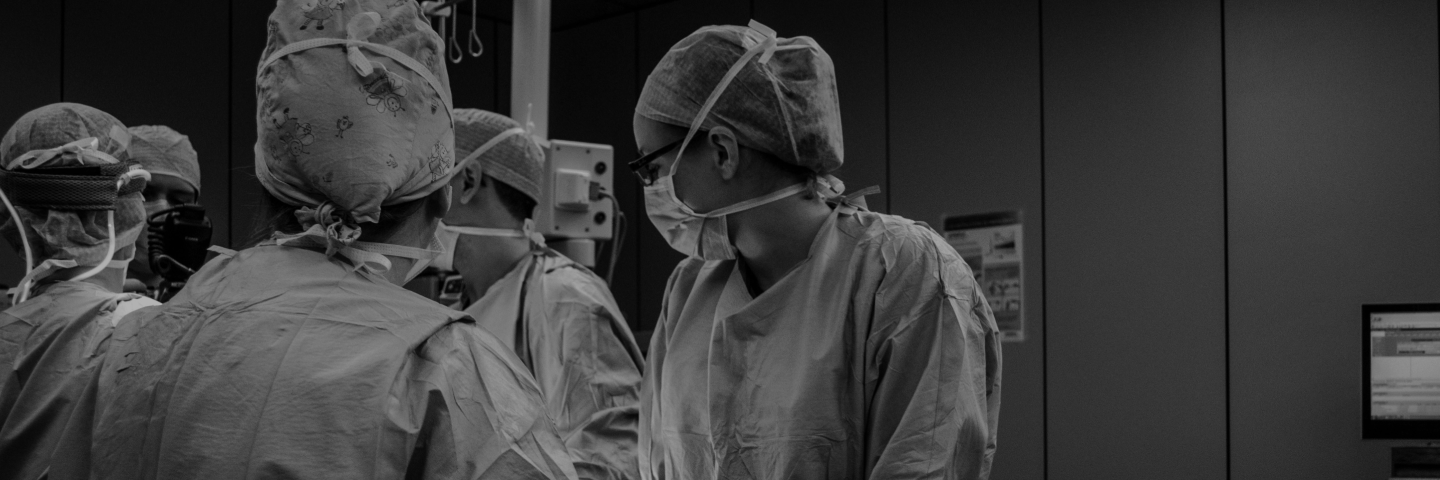About Our Research
In 2023, Kingsley Gate commissioned a study with FT Longitude (a member of the Financial Times Group) to look at several dimensions of organizational and executive decision making across industries, including healthcare.
We gathered a statistically significant response sample from the healthcare and life sciences space3, all of whom were either C-suite, C-1, or C-2 and working in large enterprises of over 1000 employees. While Kingsley Gate’s healthcare experience is largely concentrated in the United States, the geographical expanse of our research covered multiple international markets.
Key Findings
The Leadership Reality Check
When asked, 55% of healthcare executives said they were currently satisfied with how decisions are made in their organization. This number is slightly lower than the 59% of cross-industry execs who reported being satisfied.
“Only 55% of healthcare executives are currently satisfied with how decisions are made in their organization.”

This delta is the result of two factors: one, the ongoing reality that companies and executives continue to experience in the post-pandemic landscape. Two, a more protracted approach to decision making adopted by healthcare companies, either in compliance with existing regulations or to uphold the long-standing norms from academic settings (e.g., the default/status quo of having 2 or more decision makers on any given topic vs. just 1).
As McKinsey found in 2019, the typical Fortune 500 company wastes about 500,000 days of managers’ time on ineffective decision making every year, mostly on unnecessary meetings4. Many healthcare companies face similar challenges when it comes to process – decisions are often analyzed and evaluated with exacting care before action is taken, a pattern that we’ve seen lead to dissatisfaction across industries.
“The typical Fortune 500 company wastes about 500,000 days of employee time on ineffective decision making.” –McKinsey & Company

2. The relationship between speed, thoroughness, and decision satisfaction:
Despite their lower-than-average satisfaction with decision making, healthcare executives may not be able to escape the traits and attributes that drew them to the sector in the first place. Specifically, when asked which improvements would be most likely to increase their satisfaction score, healthcare respondents were less likely to select “speed” than their counterparts in other industries (34% vs. 41%) and more likely to select “thoroughness” (41% vs. 35%).
These results may be surprising given healthcare respondents’ overall satisfaction scores, but they indicate a certain ‘patient first’ mindset that is inherent to executives in the industry. For a lot of industry executives, striving for and achieving perfection means cures for patients. Executives prefer the right decision vs. a speedy one, and there is a strong desire to preserve correctness and gather a wealth of empirical evidence to inform decision making.
“Striving for and achieving perfection means cures for patients.”

3. Interviews and assessments:
In our overall sample, we found that 25% of senior executives took their current roles without having had even a cursory discussion around the topic of decision making (e.g., their past experiences with decision making, how in the role will be empowered, or not, to make decisions, their preferred working styles or approaches, etc.). In healthcare, that number rises to 29%.
While many healthcare companies apply a variety of approaches to approximate this conversation (e.g., through rigorous assessments, discussions of culture, and identification of candidates’ preferred methods), the below-average performance in the interview process in this dimension is cause for concern.

As our cross-industry research has highlighted, executives’ feeling of overall job satisfaction increases by more than 2x when they’ve explicitly discussed decision making topic as an interview topic.
Kingsley Gate is the only Executive Search firm in operation today whose approach to helping clients hire executives explicitly calls out decision making and who can guarantee that the tough questions about decision making will be asked and answered during the recruitment process.
“Executives’ feeling of overall job satisfaction increases by more than 2x when they’ve explicitly discussed decision making topic as an interview topic.”

4. Frustration and departures:
The healthcare industry is no stranger to employee attrition, including at the executive level.
M&A can be a driver towards this feeling of frustration. Decision rights can shift rapidly following a transaction and many healthcare organizations have undergone multiple rounds of M&A even within a short timeframe. Autonomy is very important to healthcare executives, with some even willing to downsize their scope, remit, or span of control if they can be guaranteed more decision-making autonomy.
“Some healthcare executives are willing to downsize their scope, remit, or span of control if they can be guaranteed more decision-making autonomy.”

One important challenge for executives is the stark reality that reliance on payors removes a lot of decision-making autonomy for healthcare executives. There is a sense that control over new offerings, pricing, and other profitability levers is always fleeting as healthcare organizations remain highly dependent on payors for reimbursement.
5. Healthcare as a human-centric business (new employees):
There are some industries where topics like HR, people development, onboarding, and employee engagement are merely “check-the-box”, “do-the-bare-minimum” type obligations, and then there are industries where the people strategy is the business strategy. For many healthcare organizations, the latter rings true.
For example, our study found that 57% cited “new employees” as a main cause of observed improvements in organizational decision-making capabilities (vs. 44% in the cross-industry sample). “New employees” are critical in a healthcare setting, compared to important but more mechanistic factors like “processes”, “data”, and “technology”.
With all the metrics put in place to measure patient and employee engagement, it can be said that in healthcare, even the data is all about the people.
“In healthcare, even the data is all about the people.”

Industry Trends
Note: The following trends perspectives are informed by Kingsley Gate’s client experience in healthcare, which has primarily taken place in the United States. The trends covered here are globally applicable but subject to country-specific payor structures.
Workflow Changes
We’ve seen significant attrition-driven labor shortages in many pockets of the industry and across roles (e.g., nurses, techs, drivers, executives). Wage laws are making it harder to attract frontline talent who could easily find fulfilling careers elsewhere), and macro challenges make it hard to attract functional executives (e.g., marketing, procurement, finance, HR) who could use their transferrable skills and move to sectors like tech, financial services, energy, and more.
We’ve seen significant attrition-driven labor shortages in many pockets of the industry and across roles (e.g., nurses, techs, drivers, executives). Wage laws are making it harder to attract frontline talent who could easily find fulfilling careers elsewhere), and macro challenges make it hard to attract functional executives (e.g., marketing, procurement, finance, HR) who could use their transferrable skills and move to sectors like tech, financial services, energy, and more.
The aging population will have a direct impact on demand for healthcare products and services, which the industry may or may not be prepared to meet. The number of U.S. residents aged 65+, for example, is expected to climb over the next 10 years which will add increased pressure on an already stretched-thin system.
Value-based care, i.e., a model by which payment is made based on health outcomes vs. a set rate, seems reasonable, but this change has proven hard as existing incentives create roadblocks to fully adopting this model. Over the past 20 years, much conversation, but relatively little action, has materialized. While there are some promising examples of success among true industry leaders, the healthcare community, as a whole, hasn’t fully embraced these models.
As cyber-attacks become more sophisticated, healthcare companies need to be ever more prepared to defend against them. Ransomware tends to be especially relevant (e.g., a threat to take down a hospital or hospital network’s entire electronic health record infrastructure unless the organization in question pays the attacker a certain ransom). Because the healthcare industry is dealing with patient lives, they are particularly vulnerable targets for these types of attackers (i.e., they are perceived to be more motivated to pay the ransom vs. companies in other sectors).
In addition, patients’ personal health data remains extremely vulnerable to attack, such as was observed in the recent 23&Me breach in October 2023. Given the emergence of new datasets and new hacking techniques, the only thing we know for certain is that there will be more breaches like 23&Me’s in the future.
Similar to value-based care, the idea of AI in healthcare comes with tremendous promise but very little realized impact to date, mostly because the topic is somewhat nascent, and regulation/ethics concerns prohibit companies from moving too quickly. Precision healthcare will be more relevant as paths forward get cleared within the regulatory framework.
Conclusion
The healthcare sector is positioned for growth, innovation and social impact. The industry is in a unique space that will continue to evolve. Executives in healthcare are facing difficult headwinds and the quality of the decisions they are making has a broad impact on our society.
For more information on how Kingsley Gate can support your executive talent needs in healthcare, please click here.
Annotations
1. McKinsey & Company. “What is Decision Making?” March 2023.
2. Bain & Company. “Decision Insights.” November 2013.
3. Kingsley Gate. “Bad Decisions: Why Companies Miss the Most Important Factor in Executive Hiring.” July 2023. Question asked: “In which sector does your organization primarily operate?”; sample comprised of respondents who selected answer choice “health and life sciences”









